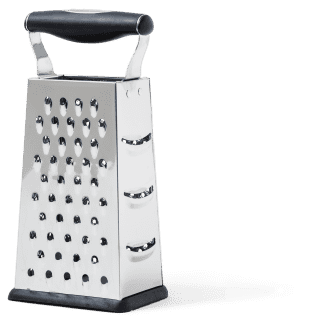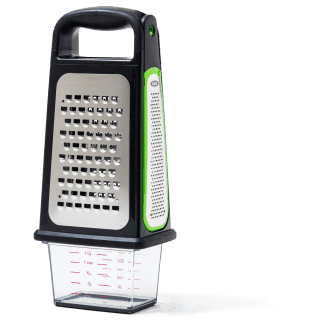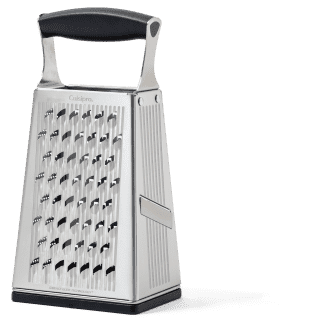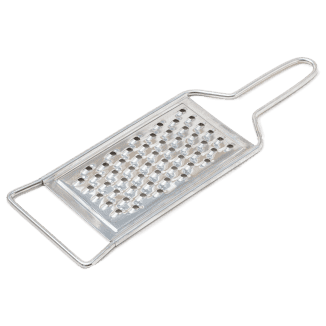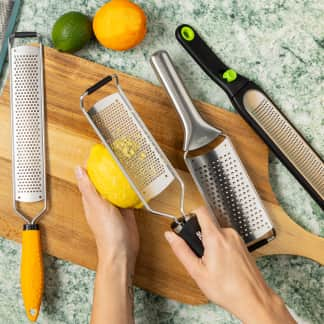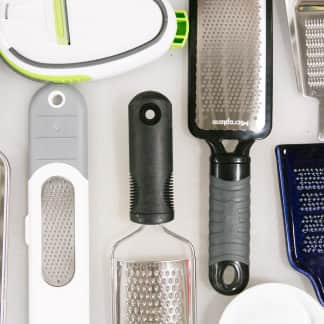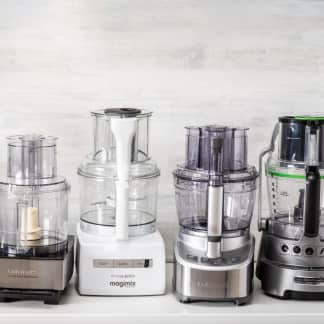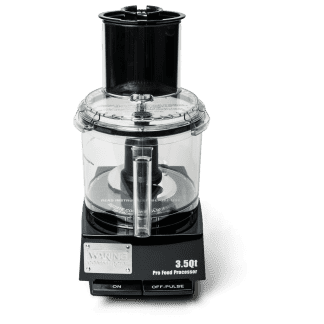The shredding disk of a good food processor can make quick work of shredding a pile of vegetables or a block of cheese, but we like to keep a grater on hand for smaller shredding jobs or for those times when we don’t want to drag out a big machine. It had been a while since we last tested these basic kitchen tools, and we wanted to know if our favorite, the Rösle Coarse Grater, still held up to the competition. So we bought eight products, priced from about $9.50 to about $36.00, and put them to the test, using them to shred soft and hard cheeses, potatoes, and carrots. Two models (including the Rösle model) were paddle-style graters, one model was two-sided, and the other five models were standard box graters. For testing, we focused on the large-holed side of the graters, since this is the side we use for shredding.
Tooth Type Is Key
While all the graters worked, a few factors made certain models shred food more quickly, more safely, and with less waste than others. The type of teeth each grater had was critical. Teeth are formed when holes are made in the grater surface in one of two ways. The holes can be stamped, or punched out of a thick, rigid sheet of metal, forming teeth that rise relatively high above the grating surface and are sharpened in a separate step by the manufacturer. Or the holes can be etched, the pattern of the holes printed photographically onto a thinner, more flexible sheet of metal, and then selectively eroded by chemicals. After the holes have been etched, the teeth are pushed up by a machine. These etched teeth sit at a lower angle to the grating surface than those on stamped models; there’s no need to sharpen them, since the etching process makes them very keen.


Stamped and etched graters alike did a decent job of shredding cheddar cheese, potatoes, and carrots. The main difference was how thickly they shredded that food—stamped graters made thicker shreds than etched graters. Curious if the shred size made a difference in cooking, we made latkes and carrot cakes with the thickest and thinnest shreds; while the textures of the finished products varied slightly, all were acceptable.

In general, however, we preferred graters with stamped teeth. Because stamped teeth usually jut out higher above the grating surface, they provide more clearance for food to pass through. Etched teeth, by contrast, sit lower on the grating plane, creating narrower openings in which food is more likely to get stuck, making your food skid dangerously as you’re shredding and taking extra time to clear. Graters with stamped teeth also shred soft, malleable foods such as mozzarella more safely and completely. Since etched teeth are pitched at a lower angle, it’s harder to get soft foods to catch on them; we had to grip blocks of mozzarella perilously close to the teeth in order to direct them. In addition, the metal used to make etched graters is thinner and more flexible than those found on stamped graters, so we often found that they buckled when we pushed the mozzarella against the grating surface, requiring us to work harder to get the cheese to maintain contact with the teeth. More often than not, we ended up extruding the mozzarella through the etched holes, creating odd, pellet-like shreds plus a lot of chunks that we couldn’t grate, since the mozzarella frequently twisted off into large, squishy pieces as we pressed it against the grater.
Box graters with etched holes do have one advantage: Their small-holed sides are much better for zesting citrus and grating hard cheeses such as Parmesan than the pinholes found on stamped graters, which clog easily. But this isn’t a big issue for us, since we rely on our favorite rasp-style grater from Microplane to perform these jobs.
Tooth Sharpness Is Also Important
Etched or stamped, the teeth had to be sharp. Right out of the box, the teeth on some of the graters were dull, so it took more time and effort to shred food—almost 2½ minutes to grate a pound of potatoes with one of the dullest models compared with just over a minute with one of the sharpest. Dull teeth also chewed through produce, rupturing cell walls and splattering juice all over our workspace. Etched teeth have a reputation for being sharper than stamped teeth; as our science research editor explained, because etched teeth are formed out of thin sheets of steel, their cutting edges have smaller bevels than those found on stamped teeth, resulting in a razor-like feel. But, when properly sharpened by their manufacturers, stamped teeth can feel just as keen—if not more so.
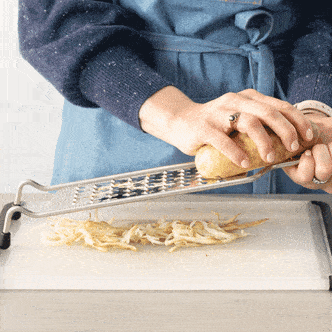
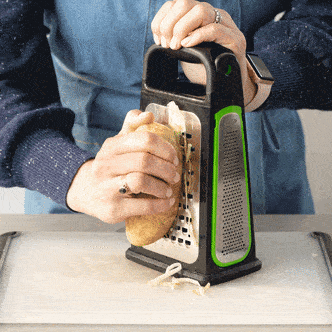
Grating Surface Dimensions Matter
The area and length of the grating surface also affected how quickly and efficiently we were able to shred food. The larger and longer the grating surface, the more ground we could cover before starting a new stroke and the less time it took to get through a batch of food. Shorter grating surfaces sometimes made it hard to complete each stroke, leaving shreds still hanging onto potatoes and blocks of cheddar and requiring more time to shred all the food.
Grater Style Is Personal, But Stability And Comfort Are Not
Testers were divided when it came to the style of grater they preferred. Some liked the paddle-style graters because they could be used in several ways—hooked over a bowl or positioned at different angles on a cutting board. Several testers also found that it was more natural to grate at an angle than to grate vertically, as with a box grater. And with a thin, washboard-like profile, paddle-style graters were especially easy to store and clean.
By contrast, box graters have a bigger footprint, and it took a little more care to extract all the shreds from their interiors. But some testers preferred these graters because their four sides allow them to sit more securely on a cutting board; this sturdiness means they require less effort to hold in place than paddle-style graters. Moreover, the box shape helps contain the shreds so they didn’t fly all over the place.
Regardless of the style, we liked graters with plastic bumpers or feet tipped in rubber, which helped keep the graters stable on a cutting board and prevented slipping and skidding. We also preferred graters with big, thick handles made from rubbery materials, which were more comfortable to hold—especially when wet—and accommodated a variety of grips.

The Best Graters: The Rösle Coarse Grater And The Cuisinart Box Grater
In the end, we came up with two winners. If you prefer the flexible positioning, easier cleanup, and smaller footprint of a paddle-style grater, we think our previous favorite, the Rösle Coarse Grater, is still your best bet. And if you like the greater security and shred containment of a box grater, we recommend the Cuisinart Box Grater. Both models feature large grating surfaces full of stamped holes with sharp teeth, so they’re able to shred hard vegetables and soft cheese quickly and with very little waste. Featuring big handles and rubber-tipped feet and bases, they are easy to hold and sit stably on a cutting board. We can’t use either tool for slicing foods or grating them more finely (we tried using the winning box grater and the results were not good), but we’re happy to reach for our favorite mandoline or rasp-style grater when we need to perform those tasks.
- Stamped holes with sharp teeth
- Large, long grating surface
- Rubber-tipped feet or plastic base
- Large, grippy handle
- Eight products priced from about $9.50 to about $36.00
- Test sharpness at the beginning and end of testing by shredding similar-size blocks of potato
- Shred blocks of whole-milk mozzarella
- Shred blocks of cheddar cheese
- Shred potatoes
- Shred carrots
- Wash according to manufacturer’s instructions 10 times
- Have testers of different hand sizes and dominant hands evaluate



